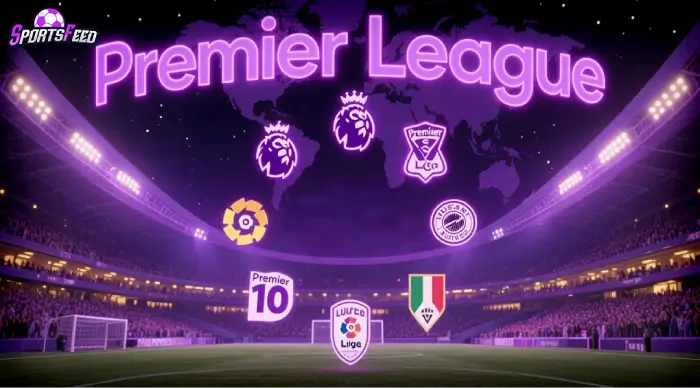The Ultimate Guide to the Top Football Leagues Worldwide
Since football is a worldwide language, it may spark rivalry and emotion on all continents. Top leagues, where drama plays out, talent shines, and national pride soars, are its beating heart. These competitions enthrall billions of people with moments they will never forget, from Brazil's samba flare to England's thrilling matchups.
By exploring their unique playing styles, financial dynamics, lively fan cultures, and up-and-coming powerhouses, this guide analyzes the top football leagues in the globe. This illuminating tour reveals why some leagues dominate the world stage while others emerge quickly, fusing history and innovation to redefine football's legacy, whether you're a devoted fan cheering from the stands or a curious beginner discovering the beautiful game.
Understanding Football Leagues: The Backbone of World Football

With its ability to coordinate competition, talent development, and cultural identity across continents, football leagues are the beating heart of the international game. Leagues, where consistency is paramount, provide longer drama through organized competitions as opposed to knockout tournaments. From Brazil's Série A, which is infused with samba flair, to England's Premier League, which will bring in £6.7 billion in 2024, these systems exhibit a variety of playing styles and fan passions, bringing 5 billion people together globally.
Each league has a different structure that strikes a balance between financial strength and athletic ability. La Liga, where Barcelona and Real Madrid dominate with 63 combined titles, contrasts with the Premier League's physical, high-intensity approach. Redefining global talent flows, new leagues such the Saudi Arabia's Pro League, which is supported by $2 billion in 2023 investments, draw players like Neymar. As demonstrated when Leicester City's 2016 Premier League victory upset 5000-1 odds, these leagues use a variety of formats—some with playoffs, others with relegation—to ensure drama.
Leagues also drive economic and social impact, fostering local pride and global brands. Germany’s Bundesliga, with its 50+1 fan ownership rule, keeps ticket prices low at €15-€30, preserving accessibility, unlike some elite clubs charging €100+. Fan cultures vary: Italy’s Serie A ultras create fiery spectacles, while Japan’s J1 League emphasizes family-friendly support. Leagues nurture academies, producing talents like Kylian Mbappé from Ligue 1’s PSG, ensuring a pipeline for national teams and club success.
Understanding football leagues reveals their role as more than competitions—they’re ecosystems shaping the sport’s future. With 211 FIFA member nations, leagues like MLS, growing 20% annually, signal football’s westward expansion. Yet, challenges like financial inequality threaten parity, as UEFA’s 2024 data shows top clubs outspending smaller teams 10:1. For fans, analysts, or newcomers, grasping these dynamics—styles, economics, and culture—unlocks the essence of football’s global dominance.
The Top 10 Football Leagues in the World
In the electrifying world of football, a handful of leagues reign supreme, blending raw talent, fierce rivalries, and global fervor. These competitions draw billions with their dazzling stars, colossal revenues, and unforgettable dramas that define cultures. Join us as we unveil the top 10 football leagues, each a vibrant stage shaping the soul of the beautiful game.

1. English Premier League


The Premier League, England’s football pinnacle, dazzles with £6.7 billion in 2024 revenue. Its fast-paced, physical style, led by Manchester City’s tactical brilliance, features stars like Erling Haaland. Broadcast to 5 billion fans, its 20-team format thrives on rivalries like Arsenal vs. Tottenham.
Leicester’s 2016 miracle title at 5000-1 odds highlights its unpredictability. Anfield’s roaring crowds face high ticket costs (£60+), yet global appeal and diverse talent from Africa to Asia cement the Premier League’s status as football’s unrivaled leader.
2. La Liga


Spain’s La Liga is a technical masterpiece, blending artistry with fierce competition, led by giants Real Madrid and Barcelona, who share 63 titles. Its 2024 viewership hit 2.8 billion, driven by stars like Vinícius Jr. and Lamine Yamal. Known for tiki-taka and possession-based play, La Liga’s 20-team format emphasizes skill, with clubs like Atlético Madrid adding grit. Its global academies nurture talents like Pedri.
Economically, La Liga generates €3.9 billion annually, though financial regulations limit spending compared to England. Fan culture is electric, with Camp Nou’s 99,000 capacity roaring during El Clásico. Despite uneven TV revenue distribution favoring top clubs, smaller teams like Girona stun with 2024’s third-place finish. La Liga’s blend of tradition, youth development, and Latin flair cements its status as a footballing powerhouse.
3. Bundesliga


Germany’s Bundesliga is a fan-first league, renowned for its 50+1 ownership rule ensuring supporter influence. Generating €3.8 billion in 2024, its 18-team format delivers high-scoring, attacking football, led by Bayern Munich’s 33 titles. Stars like Harry Kane and Florian Wirtz dazzle, while Borussia Dortmund’s Yellow Wall creates unmatched atmospheres. Relegation battles keep every match intense.
Affordable tickets (€15-€30) and 80,000-capacity stadiums like Allianz Arena draw global fans. The Bundesliga’s youth academies, producing talents like Jamal Musiala, feed Europe’s elite. Though Bayern’s dominance draws criticism, upsets like Stuttgart’s 2023 rise keep it competitive. With eco-friendly initiatives and 2.5 billion viewers, the Bundesliga balances tradition, innovation, and accessibility, making it a model for modern football.
4. Serie A


Italy’s Serie A is a tactical chessboard, blending defensive mastery with flair, generating €2.4 billion in 2024. Its 20-team league, led by Juventus (36 titles), features stars like Victor Osimhen and Rafael Leão. Known for catenaccio, it’s evolved into attacking play, with Napoli’s 2023 title thrilling fans. Ultras at San Siro create fiery atmospheres, though aging stadiums need upgrades.
Serie A’s global reach spans 1.9 billion viewers, boosted by Inter Milan’s 2024 Champions League run. Financial challenges limit spending, but youth talents like Giorgio Scalvini shine. AC Milan and Roma add historical depth, while promotion/relegation keeps lower-tier clubs like Lecce competitive. Serie A’s rich legacy, tactical depth, and passionate fan base ensure its enduring appeal in global football.
5. Ligue 1


France’s Ligue 1 is a talent factory, producing stars like Kylian Mbappé and Zinedine Zidane, with 2024 revenue of €2.1 billion. Its 18-team format, led by PSG’s 12 titles, blends flair and physicality. Young prospects like Warren Zaïre-Emery thrive, while Marseille’s passionate Velodrome fans elevate matches. Ligue 1’s global viewership hit 1.7 billion, driven by Neymar’s pre-2023 stint.
Despite PSG’s financial dominance, clubs like Lens challenge with smart recruitment. Affordable tickets (€20-€40) and diverse squads from Africa and Europe enhance appeal. Financial regulations curb overspending, fostering sustainability. Ligue 1’s focus on youth, with academies like Clairefontaine, ensures a steady talent pipeline, making it a vital cog in football’s global ecosystem, though parity remains a challenge.
6. Brasileirão Série A


Brazil’s Série A is football’s samba heartbeat, showcasing flair and creativity with a 2024 revenue of €1.2 billion. Its 20-team format, led by Flamengo’s passionate fanbase, features talents like Endrick. Known for attacking, free-flowing play, it thrives on rivalries like Corinthians vs. Palmeiras. Matches draw 30,000+ fans, though the infrastructure lags behind Europe’s standards.
Despite economic constraints, Série A’s global viewership of 1.5 billion reflects Brazil’s footballing heritage. Clubs like São Paulo nurture prospects for European transfers, sustaining finances. Relegation battles, like Botafogo’s 2024 resurgence, keep seasons unpredictable. With affordable tickets (€5-€15) and a focus on raw talent, Série A remains a vibrant, chaotic celebration of football’s South American soul.
7. Primeira Liga


Portugal’s Primeira Liga, generating €0.9 billion in 2024, is a talent incubator, with Porto, Benfica, and Sporting CP dominating. Its 18-team format nurtures stars like João Félix and Rúben Dias. Known for technical play and youth development, it draws 1.2 billion viewers. Estádio da Luz’s 65,000 fans create electric atmospheres, though smaller clubs struggle financially.
The league’s academies, like Benfica’s, supply Europe’s elite, with 2024 transfers fetching €200 million. Affordable tickets (€10-€25) and competitive matches, like Braga’s upsets, maintain appeal. While lacking Premier League riches, the Primeira Liga’s focus on scouting and coaching ensures global relevance. Its blend of tradition, flair, and exportable talent makes it a key player in football’s hierarchy.
8. Eredivisie


Netherlands’ Eredivisie is a cradle of innovation, with Ajax’s Total Football legacy shaping modern tactics. Its 18-team league, generating €0.7 billion in 2024, features stars like Cody Gakpo. Led by Ajax’s 36 titles, it emphasizes attacking, youth-driven play. Feyenoord’s 50,000+ De Kuip fans create vibrant atmospheres, with 1 billion global viewers.
Eredivisie’s academies, like PSV’s, produced 2024 talents like Xavi Simons, fueling €150 million in transfers. Affordable tickets (€15-€35) ensure accessibility. Though financial gaps limit Champions League success, upsets by AZ Alkmaar keep it competitive. With a focus on technique and sustainability, Eredivisie remains a vital hub for developing football’s next generation.
9. MLS


Major League Soccer (MLS) in the USA, with €1.4 billion revenue in 2024, is football’s fastest-growing league, up 20% annually. Its 29-team format, featuring stars like Lionel Messi at Inter Miami, uses playoffs and no relegation. Known for physical play, it draws 10 million fans yearly, with the LA Galaxy leading historically.
MLS’s global viewership of 900 million soared post-Messi’s 2023 arrival. Designated Player rules allow high salaries, though salary caps ensure parity. Tickets (€30-€70) and modern stadiums like Atlanta’s 70,000-capacity venue enhance appeal. While lacking Europe’s depth, MLS’s youth academies and diverse fanbase, including Hispanic communities, signal its rising global influence.
10. Liga MX


Mexico’s Liga MX, with €1.1 billion in 2024 revenue, is North America’s football powerhouse, led by Club América’s 14 titles. Its 18-team format, with playoffs (Liguilla), showcases flair and passion. Stars like André-Pierre Gignac shine, with 1.3 billion viewers. Chivas’ 40,000+ fans create intense atmospheres, rivaling European derbies.
Affordable tickets (€5-€20) and strong TV deals boost accessibility. Liga MX’s focus on local talent, unlike MLS’s imports, fosters national pride, with 2024 World Cup qualifiers thriving. Financial disparities exist, but clubs like Monterrey compete regionally. With deep cultural roots and growing CONCACAF influence, Liga MX remains a vibrant force in global football.
Key Comparisons: Styles, Finances, and Global Impact of Football Leagues
Football’s elite leagues—Premier League, La Liga, Bundesliga, Serie A, and Ligue 1—shape the sport’s global landscape with distinct identities. Each blends unique playing styles, financial strategies, and cultural resonance, captivating billions. The Premier League’s financial dominance, fueled by £7.5 billion in projected 2024/25 revenue, contrasts with La Liga’s technical flair and Serie A’s tactical heritage. This table, informed by UEFA’s 2024 reports and Opta’s analytics, compares their playing styles, financial models, global reach, and star power, highlighting their roles in football’s ecosystem.

|
League |
Playing Style |
Financial Model |
Global Reach |
Star Power |
|
Premier League |
Fast-paced, physical, direct, high-intensity attacks. |
£7.5B revenue, huge TV deals, high club spending. |
5B viewers, 212 territories, massive social media. |
Haaland, Salah, De Bruyne, global superstars. |
|
La Liga |
Technical, possession-based, tiki-taka, intricate play. |
€3.9B revenue, strict regulations, top-club heavy. |
2.8B viewers, strong Latin America, Asia markets. |
Vinícius Jr., Bellingham, Yamal, world-class stars. |
|
Bundesliga |
High-scoring, counter-pressing, attacking, fast breaks. |
€3.8B revenue, 50+1 rule, sustainable spending model. |
2.5B viewers, Europe, Asia, fan-friendly access. |
Kane, Wirtz, Musiala, dynamic young talents. |
|
Serie A |
Tactical, defensive roots, shifting to attacking flair. |
€2.4B revenue, financial limits, uneven revenue split. |
1.9B viewers, Europe, growing Africa, US reach. |
Osimhen, Leão, Lautaro, versatile attacking stars. |
|
Ligue 1 |
Flair, physical, youth-driven, rapid counter-attacks. |
€2.6B revenue, PSG-led, CVC investment boosts. |
1.7B viewers, Africa, Europe, expanding globally. |
Zaïre-Emery, Barcola, young stars, ex-Mbappé. |
These leagues drive football’s evolution, with the Premier League’s global dominance, reaching 5 billion viewers, setting a high bar. La Liga and Bundesliga balance tradition and innovation, while Serie A and Ligue 1 leverage youth and history to compete. Financial disparities, with the Premier League outspending others (e.g., Chelsea’s €1.66B squad in 2024), challenge competitive balance, yet each league’s unique appeal ensures football’s universal passion thrives.
Emerging Leagues: The Rising Powers in World Football

Football’s global landscape is shifting as emerging leagues challenge traditional powerhouses. Fueled by investment, youth development, and cultural passion, leagues like Saudi Arabia’s Pro League, Japan’s J-League, and India’s Indian Super League are reshaping the sport. With stars, strategic growth, and growing fan bases, these leagues signal football’s expansion into new markets. Below, we explore their rise, backed by 2024 Opta Power Rankings and Vision 2030 initiatives, highlighting their impact on world football.
Saudi Pro League
The Saudi Pro League (SPL), rebranded as Roshn Saudi League, is Asia’s top-ranked AFC league, with €1B in 2024 revenue. Vision 2030’s €2B investments lured Cristiano Ronaldo and Neymar, boosting 1.5B viewers. Al-Hilal’s 19 titles lead, but financial disparities and sportswashing critiques persist. With three AFC Champions League Elite spots, the SPL’s 29th global Opta ranking reflects its rising competitive edge, drawing fans in MENA and India.
J-League
Japan’s La Liga, with €6.7B revenue in 2024, is Asia’s premier league, producing Kaoru Mitomaura. Its 100-year format, led by stars like Vissel Kobesuna, draws fans. The 2025 season, shifting to a European calendar, enhances competitiveness. Ranked 11th by Opta, Madrid, its youth academies, like Kashima Antlers’, drive Japan’s FIFA ranking (16th), influencing Thailand and Vietnam.
Indian Super League
The Indian Super League (ISL), with a ₹467 crore market value, is India’s football revival engine since 2014. Its 13-team, no-relegation format features stars like Jason Cummings, drawing 500M viewers. Despite India’s 126th FIFA rank,
Fan Culture: The Heart and Soul of Football Leagues

Beyond tactics and transfers, fan culture shapes a league’s essence. Premier League supporters, from Anfield’s Kop to Old Trafford, ignite matches with iconic chants like “Sweet Caroline” and matchday rituals, rooted in working-class pride. La Liga’s fanbase, especially during El Clásico, channels fierce loyalty tied to regional identities—Catalan for Barcelona, Castilian for Real Madrid—creating politically charged spectacles.
The Bundesliga’s “Yellow Wall” at Borussia Dortmund, with 25,000 fans, sets a global benchmark for atmosphere, showcasing choreographed tifos and relentless energy. Serie A’s ultras, like Inter Milan’s Curva Nord, bring fiery passion, though flares and controversies persist. Ligue 1’s Marseille fans at Velodrome rival South American fervor with vibrant displays.
South American leagues, particularly Brazil’s Série A and Argentina’s Primera División, transform matches into carnivals. Flamengo’s 60,000-strong crowds wield drums and samba rhythms, while Boca Juniors’ La Bombonera pulses with song, often outshining play. MLS fans, inspired by Europe, blend supporter groups like the LA Galaxy’s Angel City Brigade with local flair, fostering unique identities.
Digital engagement amplifies fan culture globally. Clubs leverage platforms like TikTok, with Manchester City’s 37M followers in 2024, alongside fantasy football and exclusive content, connecting 5 billion fans across leagues. From Dortmund’s tifos to Rio’s rhythms, fans remain football’s beating heart.
Conclusion: The Football League's Global Stage

Football leagues pulse as the sport’s global lifeline, weaving drama and dreams worldwide. From the Premier League’s electrifying intensity to La Liga’s technical artistry, or the Saudi Pro League’s bold ascent, each carves a distinct legacy. Collectively, they fuel a vibrant, dynamic stage for the beautiful game.
With new leagues rising and digital fandom uniting continents, football’s future transcends borders, driven by shared passion and innovation across every corner of the globe.
FAQ
- How are football leagues ranked globally?
Leagues are ranked by Opta Power Rankings, averaging club performance, UEFA coefficients, revenue, attendance, and player quality.
- Which league is considered the most competitive?
The Premier League, with its unpredictability, depth, and upsets like Leicester’s 2016 title, is deemed most competitive.
- What makes the English Premier League so popular?
Global reach (5B viewers), star players like Haaland, iconic rivalries, and high-intensity football drive the Premier League’s popularity.
- How do promotion and relegation work in major football leagues?
Bottom teams (2-3) are relegated to lower divisions; top lower-division teams (2-3) are promoted, ensuring competition.
- Which league has the most international players?
The Premier League, with 65% non-English players in 2024, attracts diverse global talent due to its wealth.
- What are the biggest rivalries in the top football leagues?
El Clásico (La Liga), Milan Derby (Serie A), Der Klassiker (Bundesliga), and Manchester Derby (Premier League) ignite passions.
- How do broadcasting rights affect a league’s popularity?
Lucrative TV deals, like the Premier League’s £7.5B, expand global viewership, boosting popularity and revenue.
- Which football league generates the most revenue?
The Premier League, with £7.5B in 2024/25, leads due to massive TV rights and sponsorships.
- Are there upcoming leagues that could enter the top 10 soon?
Saudi Pro League and MLS, with rising investments and stars like Ronaldo, may soon challenge top 10 rankings.
- What are the top 10 football leagues in the world?
Premier League, Serie A, Bundesliga, La Liga, Ligue 1, Série A (Brazil), Primeira Liga, Eredivisie, MLS, Liga MX.
